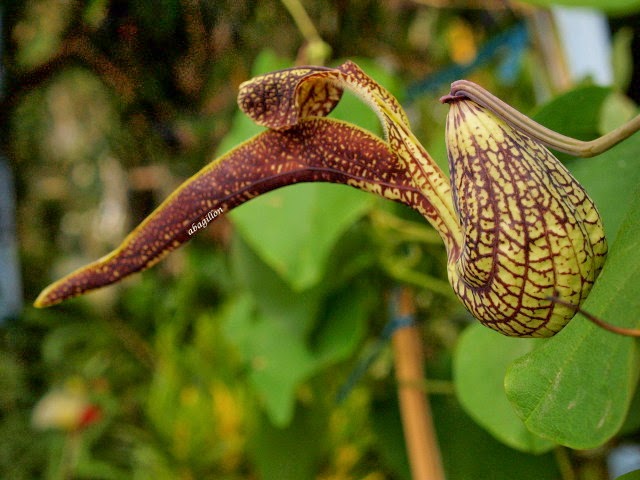Happy Valentine's Day my Dear Blogger Friends! I am putting 14 plants here to signify Valentine's Day.
Our cold temperature experience only lasted for 3 weeks in January- February, courtesy of the cold spillage from Russia and North China. We had then 19°C in the mornings before sunrise, and you people from the temperate countries, please don't laugh! This is the coldest we receive so far, and we are so thankful for the lovely experience. We all wish to have it longer, so we will be more efficient, more relax and of course, happier. Since last week, the easterlies with warm air from the Pacific got here again, and we are now above 30°C, our normal temps. Our dry season has not officially started, but we feel that we are already in it. Actually, this is already the beginning of our dry season. The symptoms around us confirmed all these.
The city sidewalks grasses are now brown. Many of the trees are shedding their leaves and the skies are clearer through them. Our home garden also changes its character.
Orange shrimp plant, Mexican plume,
Justicia fulvicoma. This is a new plant snipped by my mother from relatives, and seems to thrive well with us, but needs watering.
Above and below are both Impatiens balsamina, both rainy season plants here. They are now at the end of their lives evidenced by the maturing pods and dehiscing flowers.
Odontonema strictum is also a rainy season plant, but it still produces flowers because it is planted under canopies of trees.
We have some plant types depending on our 2 seasons. Those above die during the dry months, while those below persist throughout the dry season despite their pitiful conditions. Most of them i trim and prune to get rid of the lanky bald branches and to produce healthy growths again come rainy months.
This bush lantana is a prolific grower during the dry season, but is now showing old age. This condition of yellowing leaves and less flowers even aggravates during the dry season and must be pruned before the rainy season begins.
Sanchezia speciosa, which i favored for its leaves is now tall and starts to produce blooms. I just pinch the growing points to delay its aging. I don't like it when a lot of protruding inflorescence comes out. Some tips were missed and still produce some flower buds like that below.
The crotons or
Codiaum variegatum produce flowers at the start of the dry season. I guess that is its genetic code to continue the species because dry season might extinguish them, they are just trying to ensure continuity of species. But they are tolerant of our dry season like the Lantana and the Sanchezia.
Above is a flower umbel in a croton flower spike.
Another tolerant or even resistant species is this Dracaena surculosa. A lot of flowers are produced this time, with wonderful scent at night around 9:00pm. In the morning, these flowers are already closed and the scent just happens during the time of blooming.
Dracaena surculosa blooms are not only sweet scented, they also look like sparklers in the dark! I am so glad it is planted just near the living room, flooding us with its mild scent while we are viewing TV.
Ixora javanica is a tree species, producing bigger and heavier umbels. This particular plant is maybe around 10 ft tall. It also normally starts flowering at the start of the dry season continuing until May when the rains start to arrive. It is mostly vegetative throughout the rainy months.
The above yellow cosmos came from seeds i got from a trip, only 1 plant grow to this height. It was just cared for with constant watering, so able to grow nicely in a pot. The petioles are reddish so i am expecting some different pinkish petals when the flowers mature.
Among our plants, the above is the newcomer, as it's just been exhumed from the wild portion of our property where we normally thread upon. I originally thought it was a hoya so am ecstatically expectant for it to bloom. However, blooms after a few months proved it is not a hoya, maybe Dischidia rosea or Dischidiopsis parasitica, with those lipstick-like dark red flowers. But the plant itself is lovely in a hanging basket. I guess i will love it together with the hoyas.
This orange Crossandra infundibuliformis is a newly acquired plant too. It shows invasiveness and can withstand our long dry season. It also has a red variety.
This one is the most tolerant because it has been with us since time began! We normally erradicate this in the property, but now i allow a few plants because the butterflies very much love them. It is bushy that produces maybe 4-5 inflorescence per plant, so you can imagine the butterflies visiting them.
Of course i will not end the Garden Bloggers Bloom Parade without showing the plant that is keeping me busy while at home. They actually get most of my weekends. I arrive after lunch on a Saturday and leave at 3pm the next day, and these hoyas make me feel like i still need more time at home. There are no blooms last weekend, but the peduncles are enough to make my weekend so rewarding. It might take 3 more weeks for the above to open and i hope to come home again with them still in full show! I will post them next month's GBBD if they will wait for me.

























